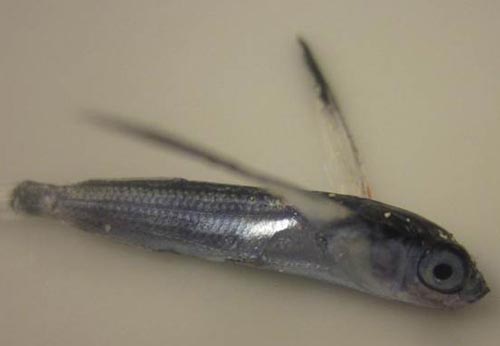Published in the Ocean Watch column, Honolulu Star-Advertiser © Susan Scott
September 27, 2010
 A recent study found that flying fish, malolo, can glide over the water’s surface as competently as some seabirds. Well, we knew that. Hawaii’s anglers, sailors and surfers have all watched, amazed, as a malolo rocketed from the water and flew on and on and on. How long, I often wondered, can a fish keep gliding like that?
A recent study found that flying fish, malolo, can glide over the water’s surface as competently as some seabirds. Well, we knew that. Hawaii’s anglers, sailors and surfers have all watched, amazed, as a malolo rocketed from the water and flew on and on and on. How long, I often wondered, can a fish keep gliding like that?
The official answer is 40 seconds. In that time a malolo can travel about 1,300 feet, or a quarter-mile. And they’re fast, shooting from the water at up to 37 mph. When the fishes’ momentum begins to slow, malolo dip the bottom of their rudderlike tails into the water and scull.
But even with such a marvelous escape technique, malolo just can’t win. If a flying fish manages to escape the mahimahi, tuna, billfish or dolphin pursuing it, it is then often plucked from the air by a sharp-eyed seabird. Or the malolo lands on the deck of a passing boat and gets eaten by a cat.
Years ago I met a cruising couple in Panama who sailed with a much-loved cat named Tico. Tico was crazy about flying fish, and when he heard the familiar thump on the deck, he would rush out to grab it.
This was OK during the day when the couple could watch the cat, but at night, fearing Tico would fall overboard, the owners barricaded the pet below deck with one of the sleeping owners while the other stood watch in the cockpit. Still, on countless mornings the couple found winglike fins and scales in Tico’s fish-stinky bed.
After some sleuthing, the couple discovered that at night when Tico heard the crash landing of a flying fish, the cat cleverly escaped his confinement and waited in the dark companionway for the watch person to nod off. When the moment was right, the cat ran to the deck, snatched the fish and rushed below.
For his resourcefulness, Tico had to suffer the indignity of a leash.
Tico got to eat flying fish only in the tropics and subtropics because the world’s 40-some species love warm water and migrate toward it. In winter, malolo move toward the equator, and in summer they head toward the poles. Flying fish are abundant in 77-degree water, common in waters 71 degrees and sparse in colder water.
These warm-water migrations make flying fish more plentiful in Hawaii waters in the summertime when our water temperatures are highest (81 degrees) than in winter when temperatures are the lowest (71 degrees off Hilo).
Nine species of malolo swim in (and fly over) Hawaii’s waters, ranging in size from less than an inch long to about 16 inches long.
Malolo attach their sticky eggs to anything that floats, such as seaweed, pumice, driftwood, fishing line and plastic. One theory of why so much plastic is found in Laysan albatross nests, and in their stomachs, is that the buoyant plastic contains malolo eggs, one of this seabird’s main foods. The foraging parent swallows the egg-laden plastic, flies home and regurgitates the meal, plastic and all, into the mouth of a waiting chick. The lucky chicks digest the eggs and throw up the plastic. The unlucky ones accumulate plastic in their stomachs and die.
Malolo eat animal plankton, and just about everything eats malolo and their eggs, including humans.
Judging from fish prints, T-shirts and boat, bar and company names, we Hawaii residents are quite fond of our sleek, silvery malolo.
But then, how could anyone not love a fish that flies as well as a petrel?